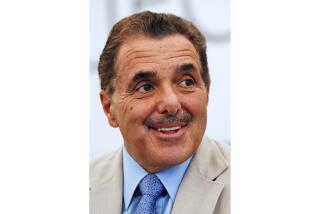Success Smells Sweet : Retailing: Chief Executive Officer Michael Gould has helped Giorgio Beverly Hills solidify its status as a leader in the perfume industry.
What a difference a few years make. Back in 1986, Michael Gould was unceremoniously ousted as chairman and chief executive of Robinson’s department stores and branded an overspender. He landed at the fragrance firm now called Giorgio Beverly Hills, only to be enveloped by a nasty feud between Fred and Gale Hayman, the divorced society couple who then owned the business.
But Gould--once a young hotshot in the department store business--is riding high again. After the smoke cleared at Giorgio Beverly Hills, he emerged as the man in charge, and under his direction the company has regained its momentum and solidified its status as a leader in the perfume trade.
How did Gould, 47, reignite a sputtering, dissension-wracked firm and put his own career back on track? Among other things, he introduced a new perfume, Red, that has become the nation’s top seller. At the same time, Gould preserved the firm’s Beverly Hills cachet by hewing to a policy of hand-picking the stores allowed to sell its fragrances.
And, just as important, Gould has spurred Giorgio through the force of his own gregarious personality. A lanky, gravelly voiced man with an accent right out of a Boston schoolyard, Gould is a master motivator who charms, blusters and teases to get what he wants.
“Michael has more charisma than anyone I’ve ever worked with,” said a beaming Linda LoRe, Giorgio’s senior vice president for marketing. She is one of the cadre of former Robinson’s executives who followed Gould to Giorgio.
Gould also is adept at jawboning his retailing contacts to grab good display space at department stores.
“He’s street-smart,” said H. Michael Hecht, chairman of the Broadway-Southern California chain. “He’s competitive. He wants to be recognized as No. 1.”
Not that everyone has nice things to say about Gould. Joseph H. Johnson, a retired retailing executive who, as chairman of Associated Dry Goods, pushed Gould out of Robinson’s, refused to talk about him.
Also unwilling to comment were Gale and Fred Hayman, who brought in Gould as Giorgio’s chief operating officer but wound up warring with him.
For his part, Gould initially resists talking about the Haymans, but sometimes his anger flashes. “You’d think that people who made $240 million or $250 million in profits would be happy, not worried about who deserves credit,” said Gould.
Gould also curtly dismisses a recent book on Giorgio, “Reeking Havoc.” It described Gould in his Robinson’s days as turning from a corporate “wunderkind” to “the organization’s Colonel Kurtz,” the Marlon Brando character in the movie Apocalypse Now, who left his command to “carve out his own fiefdom in the bush.”
These days, Gould is looking to the future by diversifying Giorgio. At their Santa Monica headquarters--where the scent of perfume is no more noticeable than at an insurance office--Giorgio executives are mapping plans for the next year. They expect to open several new boutiques across the country, push sales of the firm’s fragrances overseas and license its name for products ranging from sunglasses to sportswear.
The firm expects revenue of nearly $200 million for 1990, largely from sales of Red and its namesake Giorgio Beverly Hills perfume--which itself reigned for four years as the nation’s top-selling fragrance until being displaced by Red. Giorgio also sells men’s fragrances (Gould says he slaps some on a few times a week), and it operates boutiques on Rodeo Drive in Beverly Hills and on East 57th Street in Manhattan.
What the company needs, Gould said, is to branch out and get away from being dependent on one or two hit fragrances.
“I don’t want to just be a fragrance business in the U.S.,” Gould said. “I want to be a worldwide business.”
To achieve that goal, Gould has been given a large measure of independence by Giorgio’s parent, New York-based cosmetics giant Avon Products Inc. Avon bought Giorgio from the Haymans in 1987 for $165 million and then asked Gould to stay on as head of the business.
Avon, the target of repeated takeover attempts, tried for five months last year to sell Giorgio. James E. Preston, Avon’s chairman, said Giorgio attracted “multiple offers,” but none reflected the firm’s true worth. He said he now plans to keep the firm.
If Gould was ever rattled about Avon’s changing plans, he didn’t let his staff know. He is a sentimental man who seems to work hard to keep morale high, churning out a constant stream of one-sentence “great job” notes and calling staffers to acknowledge their birthdays.
Gould also is known as a boss who delegates responsibility and takes pride in making Giorgio a place where employees can take chances. Said LoRe, the marketing chief: “He’s not one to say ‘My way or the highway,’ but he’s also one who’s not afraid to say, ‘That’s bull,’ either.”
Sabra Lande, Giorgio senior vice president for retailing and licensing, tells the story of what happened when she took Gould to Giorgio’s current Rodeo Drive boutique two weeks before it opened last October. The lighting fixtures and merchandise, among other things, weren’t in place yet, and Gould had a hard time visualizing how the store would come across to customers.
According to Lande, Gould’s reaction was: “I don’t get it, but if you like it, I’m sure it’s fine.”
Gould, the son of a Massachusetts Institute of Technology biochemistry professor and the grandson of a Talmudic scholar, says in some respects he sees his role as that of a teacher. But he never seriously considered an academic career.
He attended Columbia University as an undergraduate and stayed on to get an MBA. Gould says he was planning to attend law school, but was drawn to a retailing career after he took a summer internship at the Brooklyn-based Abraham & Straus department stores.
The attraction of retailing, Gould says, was the opportunity for a young manager to run a department doing millions in business. At A&S;, he climbed through the ranks to become the company’s youngest vice president.
Gould also started making his network of retailing contacts at A&S;, at the time a hothouse of executive talent. Allen Questrom, the former head of the Neiman Marcus chain and now chairman of Federated and Allied department stores, also was at A&S; in those days. Millard S. Drexler, now president of Gap, is another friend of Gould from A&S.;
Robinson’s brought Gould to Los Angeles in 1978 as a senior vice president, and within three years he was promoted to chief executive. Industry observers credit Gould with instilling new life and building business at the sagging Robinson’s chain by bringing in European fashions and using splashy promotions.
Expenses for promoting the stores got out of hand, however, and relations between Gould and Associated Dry Goods’ Johnson went bad. One Gould associate said that his ouster had more to do with bad chemistry between the two men than the performance of the Robinson’s stores.
Gould quickly jumped to Giorgio, and in some ways it seemed like a natural move. Robinson’s was Giorgio’s biggest account, having sold $11 million of the original Giorgio Beverly Hills perfume in 1985.
Fred Hayman--then fighting with his ex-wife as well as with two of the firm’s key executives--needed a steadying hand at the firm. But the Hayman-Gould marriage quickly fell apart, and shouting was heard in the hallways.
As Gould was giving serious thought to quitting, Avon called on the Haymans and bought them out. Avon’s Preston said he decided to retain Gould partly because of his strong reputation in retailing--a new area for Avon, which has long specialized in selling cosmetics door-to-door.
With the support of Avon, Gould went about building the sales force and other departments, roughly tripling the firm’s overall employment to its current total of more than 300. The firm’s namesake Giorgio Beverly Hills perfume was the industry’s phenomenon of the 1980s, but sales were tapering off. The new regime brought the fragrance’s business back up for a while, and even though sales now are fading again, it still ranks among the nation’s five top perfumes.
Giorgio scored another big coup with the introduction of its new women’s fragrance, Red. It made the firm one of the few in the perfume business to come out with two smash hits in close succession.
In some ways, the Red marketing campaign has succeeded by using the same strategies that the Haymans did. For one thing, it limited the lineup of stores selling the fragrance. The campaign also avoided expensive television image advertising in favor of “scent strips” in women’s magazines to let potential customers get a whiff of the product.
But Gould gets credit for, among other things, selecting the new fragrance from among several contenders.
Red is a subdued scent designed to capture the “more mature” woman of the 1990s. Giorgio Beverly Hills, on the other hand, has such a strong scent that one New York restaurant bars cigars, pipes and Giorgio.
While tapping a different consumer mood, Red also neatly avoids siphoning off sales from its sister fragrance.
Despite the success of the new product, Gould isn’t ready to take it easy and start smelling the roses. He draws his inspiration from Will Rogers: “Even if you’re on the right track, you’ll get run over if you just sit there.”






